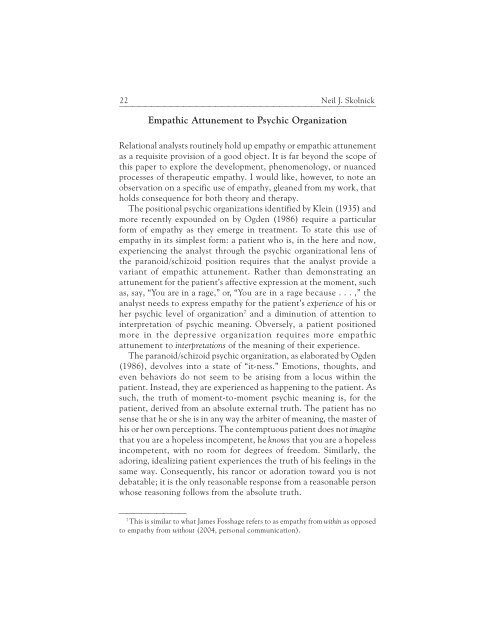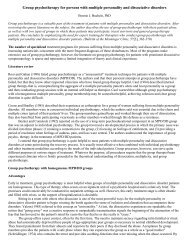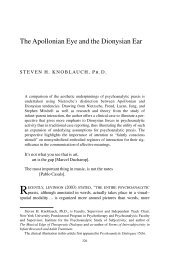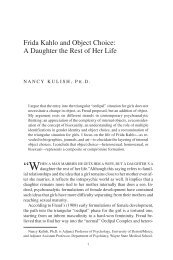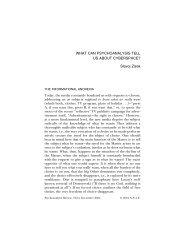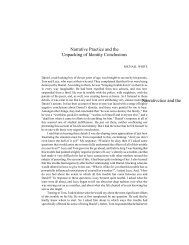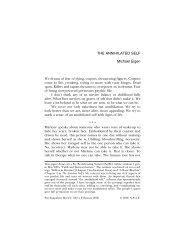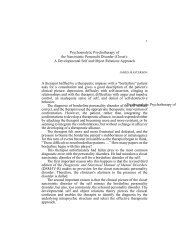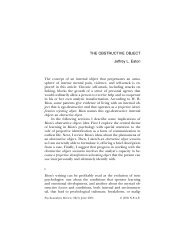What's a Good Object to Do? - PsyBC
What's a Good Object to Do? - PsyBC
What's a Good Object to Do? - PsyBC
Create successful ePaper yourself
Turn your PDF publications into a flip-book with our unique Google optimized e-Paper software.
22 Neil J. Skolnick<br />
⎯⎯⎯⎯⎯⎯⎯⎯⎯⎯⎯⎯⎯⎯⎯⎯⎯⎯⎯⎯⎯⎯⎯⎯⎯⎯⎯⎯⎯⎯⎯⎯⎯⎯⎯⎯⎯⎯⎯⎯<br />
Empathic Attunement <strong>to</strong> Psychic Organization<br />
Relational analysts routinely hold up empathy or empathic attunement<br />
as a requisite provision of a good object. It is far beyond the scope of<br />
this paper <strong>to</strong> explore the development, phenomenology, or nuanced<br />
processes of therapeutic empathy. I would like, however, <strong>to</strong> note an<br />
observation on a specific use of empathy, gleaned from my work, that<br />
holds consequence for both theory and therapy.<br />
The positional psychic organizations identified by Klein (1935) and<br />
more recently expounded on by Ogden (1986) require a particular<br />
form of empathy as they emerge in treatment. To state this use of<br />
empathy in its simplest form: a patient who is, in the here and now,<br />
experiencing the analyst through the psychic organizational lens of<br />
the paranoid/schizoid position requires that the analyst provide a<br />
variant of empathic attunement. Rather than demonstrating an<br />
attunement for the patient’s affective expression at the moment, such<br />
as, say, “You are in a rage,” or, “You are in a rage because . . . ,” the<br />
analyst needs <strong>to</strong> express empathy for the patient’s experience of his or<br />
her psychic level of organization 7 and a diminution of attention <strong>to</strong><br />
interpretation of psychic meaning. Obversely, a patient positioned<br />
more in the depressive organization requires more empathic<br />
attunement <strong>to</strong> interpretations of the meaning of their experience.<br />
The paranoid/schizoid psychic organization, as elaborated by Ogden<br />
(1986), devolves in<strong>to</strong> a state of “it-ness.” Emotions, thoughts, and<br />
even behaviors do not seem <strong>to</strong> be arising from a locus within the<br />
patient. Instead, they are experienced as happening <strong>to</strong> the patient. As<br />
such, the truth of moment-<strong>to</strong>-moment psychic meaning is, for the<br />
patient, derived from an absolute external truth. The patient has no<br />
sense that he or she is in any way the arbiter of meaning, the master of<br />
his or her own perceptions. The contemptuous patient does not imagine<br />
that you are a hopeless incompetent, he knows that you are a hopeless<br />
incompetent, with no room for degrees of freedom. Similarly, the<br />
adoring, idealizing patient experiences the truth of his feelings in the<br />
same way. Consequently, his rancor or adoration <strong>to</strong>ward you is not<br />
debatable; it is the only reasonable response from a reasonable person<br />
whose reasoning follows from the absolute truth.<br />
⎯⎯⎯⎯⎯⎯⎯⎯⎯<br />
7<br />
This is similar <strong>to</strong> what James Fosshage refers <strong>to</strong> as empathy from within as opposed<br />
<strong>to</strong> empathy from without (2004, personal communication).


